- Quick Read
- Deep Read ( 13 Min. )
In Today’s Issue
- Amid anger and destruction, Kenoshans seek reconciliation
- Punishment or rehabilitation? Why America locks people up. (audio)
- Mediterranean face-off: Greece, Turkey at ‘the abyss’
- A Canadian First Nation reclaims the telling of its own story
- Before Serena Williams and Megan Rapinoe: Early female athletes paved way
Monitor Daily Podcast
- Follow us:
- Apple Podcasts
- Spotify
- RSS Feed
- Download
TODAY’S INTRO
The cop’s son and the quarterback
 Mark Sappenfield
Mark Sappenfield
Last week, as the emotion of the police shooting of Jacob Blake swept through America, many sports teams paused. Some leagues held temporary strikes. Others canceled practices. For many, deep conversations happened.
The one inside the Indianapolis Colts locker room was familiar. Black players like linebacker Zaire Franklin and quarterback Jacoby Brissett shared what it is like to be Black in America – always under suspicion, constantly feeling threatened by those employed to protect you.
Then Ryan Kelly stepped in – and spoke for the police. His father was an officer for 30 years, and this year the Colts’ center was keynote speaker at a Concerns of Police Survivors ball, held for officers killed in the line of duty. He spoke of the good cops he knew and the misunderstanding he saw. And his teammates listened.
“I’ve had conversations that I never thought I would have with Ryan,” Brissett told The Athletic. “He’s provided tremendous insight and he’s provided ideas that, honestly, I would have never thought of. ... He’s opened eyes and, I think, vice versa.”
Sports can inspire and amaze. But they can also teach, and on a team where a white cop’s son is employed to defend from opponents a Black man who has spoken out in support of Black Lives Matter, the lessons are larger than X’s and O’s. Said coach Frank Reich: “The way our team handled that was the way it should be handled: with respect, listening, and it was a two-way street. And it requires a maturity that’s beyond your years to hang with it and get deeper into the discussion.”
Share this article
Link copied.

Help fund Monitor journalism for $11/ month
Already a subscriber? Login

Monitor journalism changes lives because we open that too-small box that most people think they live in. We believe news can and should expand a sense of identity and possibility beyond narrow conventional expectations.
Our work isn't possible without your support.
A deeper look
Amid anger and destruction, Kenoshans seek reconciliation
The world’s picture of Kenosha, Wisconsin, is of the city set ablaze by riots after the police shooting of Jacob Blake. Today, its streets show the nuance of America’s racial narrative and the humanity that is never extinguished.
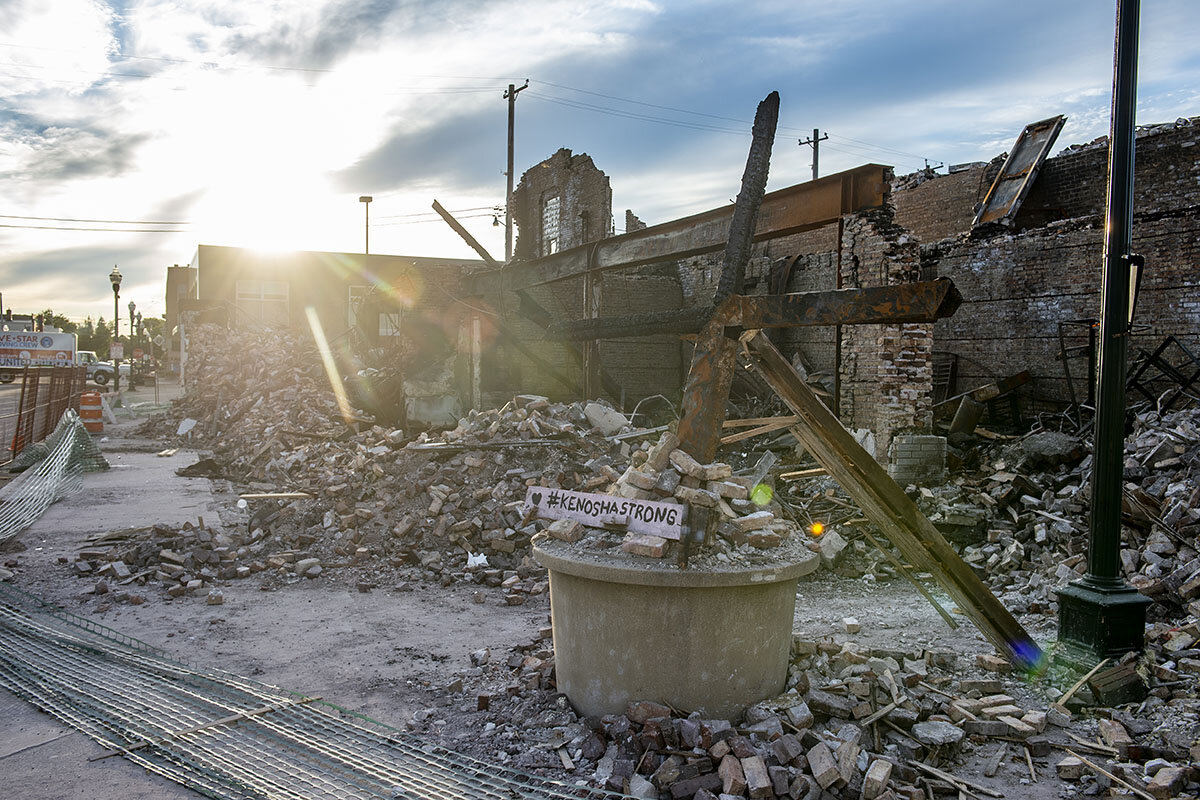
-
Story Hinckley Staff writer
What will Kenosha be remembered for? Jacob Blake’s shooting by police and the violence that ensued have thrust this Wisconsin city into the national spotlight, with politicians using it to advance narratives about the need for racial justice and law and order.
Residents present a more nuanced view, describing – often through tears – a city striving to express unity in the wake of devastation. Some characterize this pivotal moment as a wake-up call for those who have failed to see or address persistent racial discrimination, and an opportunity for healing. While a broad cross section of residents see their city as a microcosm of the tumult across America, many are hopeful that Kenosha will be remembered not for violence but as a model of resilience and reconciliation.
“I was raised up around oppression,” says Andre Ross, leaning against the hood of his white Pontiac, drinking McDonald’s coffee in front of what used to be Uptown Restaurant, where he met friends every Saturday morning for breakfast before it was burned last week. “But I go to church. You can’t deal with violence with violence. That’s what you call a war. Ain’t nobody going to win.”
Amid anger and destruction, Kenoshans seek reconciliation
Andre Ross is leaning against the hood of his white Pontiac, drinking McDonald’s coffee in front of what used to be Uptown Restaurant. He’s staring at the boarded up and burned out strip of businesses along 22nd Avenue, which served mainly Black patrons.
“I used to get my phone there. ... And then those tacos over there I used to get,” he says, gesturing up and down the now-quiet street. “And that lady over there at the end, she used to sell mattresses and sometimes people would be short with the money, and she’d just let them have it.”
Mr. Ross lives a couple of miles away by the police station, where all the new fencing around a National Guard outpost – visible from his backyard – makes him feel as if he’s living in Afghanistan. Some 1,000 troops have been sent in over the past week to curtail the violence that ensued after a police officer shot Jacob Blake in the back on Aug. 23.
“I had to come down here and eat my breakfast and see it all,” he says. “I see this happen on TV in different cities. But my little city of 100,000 people?”
“I understand that Black Lives Matter, I understand all of that. But what I don’t understand is this,” says Mr. Ross, looking at the charred hulks of brick, twisted rods, and melted glass left in the wake of the violence. “If you don’t know a way to be heard, you need to find a way. Because this is not the way.”
Mr. Blake’s shooting, the three nights of burning and looting that followed, and a white teenager’s fatal shooting of two aggressive protesters have thrust this Midwestern city into the national spotlight. President Donald Trump surveyed the damage and met with law enforcement officials on a visit today, during which supporters and protesters engaged in shouting matches along the presidential motorcade’s route. As pundits and officials across the political spectrum turn Kenosha into a rallying cry for racial justice or law and order – or both – residents offer a more nuanced view.
Many tearfully describe a city striving to come together in the wake of devastation. Some characterize this moment as a wake-up call for those who have failed to see or address persistent racial discrimination – and as an opportunity for healing. While a broad cross section of residents see their city as a microcosm of the current tumult across America, many are hopeful that Kenosha will ultimately be remembered not for the violence that occurred here but as a model of resilience and reconciliation.
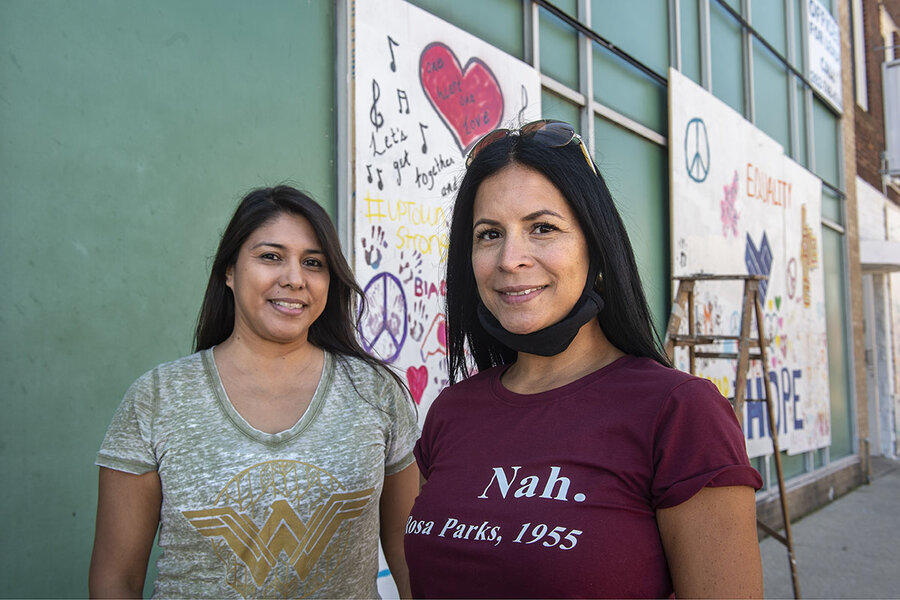
“I would really like the country to know us for this tightknit community you see,” says Elisa Rocha, finishing up a mural across the street from the burned remains of the Danish Brotherhood hall, where her extended family used to gather for Thanksgiving, Christmas, and quinceañeras. Along the blocked-off street, the air is thick with barbecue smoke as volunteers flip hamburgers and pass out corn on the cob, while others collect cash donations in makeshift boxes.
“We will get through this and we will come out stronger,” says Ms. Rocha. “They’ve destroyed the buildings and the homes, but they’re not going to destroy the spirit that this city has.”
A legacy of racial divisions
An older white couple eating hot dogs piled high with condiments watch as others wait in line for food and some dance to the music coming over the loudspeakers. They say they want to think of their city as coming together. But they point out that the crowd here is made up of mostly white Kenosha residents, while around the corner at the Family Dollar there’s a similar gathering that’s all Black families.
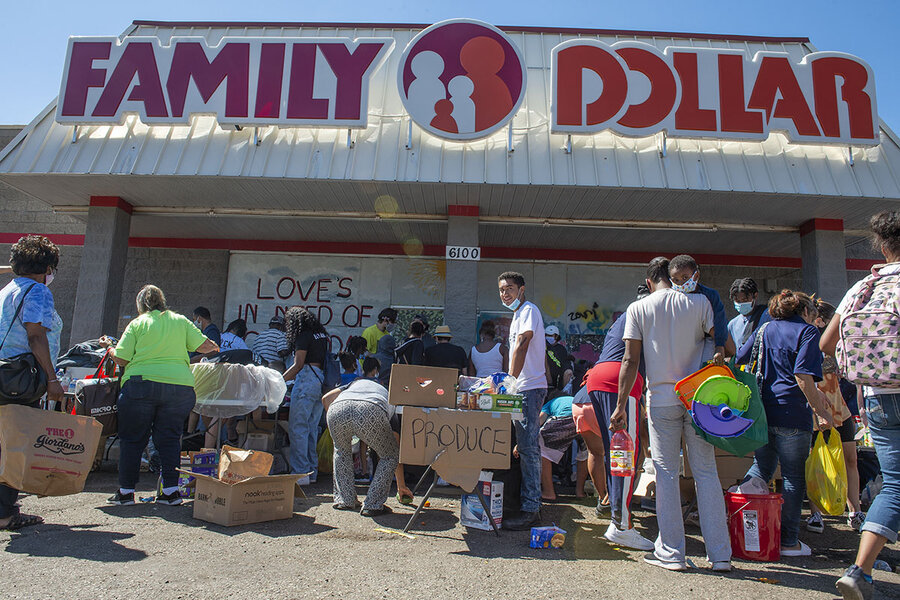
“So have we really come together?” asks the wife, Holly, who declined to give her last name.
Even as a small army of residents paint colorful messages of unity, love, and healing on the plywood that covers shop fronts across the city, others express discouragement about the racial divisions that persist here – a legacy of Wisconsin’s history.
Although the state never legalized slavery and was an important stop on the Underground Railroad for slaves seeking freedom in Canada, Wisconsin chose to omit Black suffrage in its 1848 state constitution. A century later, the state’s Black population increased almost 600% from 1940 to 1960 due to a surge in industrial employment, including in Kenosha, where Chrysler and American Motors were a big draw. But Milwaukee – less than an hour’s drive to the north – remained one of the most segregated cities in the country.
A recent Brookings report found that those disparities have persisted: In 2019, Milwaukee was rated the most racially segregated metro area in the United States. While some neighborhoods in Kenosha are integrated, segregation still persists in areas where mortgage lenders used redlining to restrict where Black homebuyers could live, says Lawrence Kirby, pastor of Acts Church.
“Our city is still incredibly divided in a lot of ways,” says Pastor Kirby, likening residents to relatives that only get together for funerals. “In the protests and outrage, you see people come together, but we’ve got to get to the point where we’re doing life together in a regular way more and more.”
A few blocks away from the Danish Brotherhood ruins, Ionia Ireland and her 10-year-old daughter Aya are standing on upside-down buckets, painting the plywood on the boarded-up business below their apartment. Ms. Ireland, a retired Marine, expresses grim bemusement that her Uptown neighborhood lately has seen a steady stream of white people driving by, holding cellphones out the window as they film the destruction.
“There’s a lot of people who are coming here and spray-painting a couple of things, passing out a couple of chips, taking a few pictures to be on Facebook and Instagram like they’re this hero – and then they leave,” she says. “I’m not saying all are like that, some of them genuinely do care.”
“I think it’s safer from where we used to live in Milwaukee,” her daughter Aya adds. “But my candy shop almost burned down!” Her mom notes that Uptown was already on the verge of being a food desert, and ticks off the last few places they had left to shop for food, all of which have been destroyed. Aya chimes in: “And Family Dollar! Just went poof!”
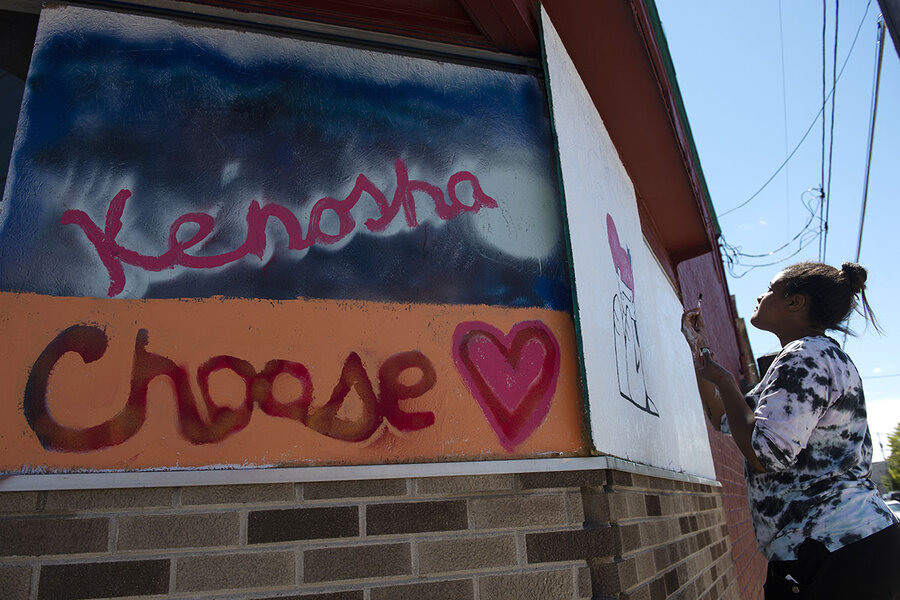
In Family Dollar’s parking lot, dozens of people are rifling through donated T-shirts, diapers, canned goods, and bottled water. Milwaukee-based rapper WebsterX, who co-organized the relief effort, expresses frustration that outlets like Fox News focused on the fires but aren’t here to report on the recovery.
“What I want people to pay attention to in Kenosha is the positivity that’s also happening,” he says, with music reverberating in the background. But he also says that there has been “racist stuff happening here for forever, and in these communities and cities it’s just extremely unbalanced – economically, socially.”
“I want people to come to Kenosha and understand why Kenosha,” he says. “People are in unrest, they are angry, because Black people are being killed and it’s as simple as that.”
Piecing together what happened
Kenosha police officers have come under fire after a video went viral showing Officer Rusten Sheskey shooting Jacob Blake seven times in the back as he tried to enter an SUV where his three sons were sitting in the backseat. According to a statement from the Kenosha Professional Police Association, officers were responding to a complaint that Mr. Blake, who had an open warrant for felony sexual assault (third degree), was attempting to steal the caller’s keys and car. The caller referred to Mr. Blake as her boyfriend, and his attorney said the pending charges for sexual assault and domestic abuse involved the same address where his client was shot, according to the local CBS affiliate.
The police union statement asserts that the officers gave Mr. Blake, whom they say was carrying a knife, multiple opportunities to comply with verbal and physical cues – including a taser – before they fired their first shot. Another bystander video appears to show Mr. Blake scuffling on the ground with officers before any shots were fired. Dispatch audio reveals that less than three minutes elapsed from when the first officer arrived to when Mr. Blake was shot. Mr. Blake’s attorney said in a statement his client “did nothing to provoke police” and that “witnesses confirm that he was not in possession of a knife.”
Mr. Blake, whose family has said he is paralyzed from the waist down, was initially shackled to his hospital bed until his warrant was vacated several days later. The Wisconsin Department of Justice is investigating the shooting and is expected to present its findings in a month. Within hours of the shooting, protests began. A car dealership was torched that night, along with a state parole and corrections building, with widespread arson continuing on Monday and Tuesday nights. On Tuesday, Aug. 25, 17-year-old Kyle Rittenhouse of Illinois fatally shot two protesters and injured a third, Gaige Paul Grosskreutz, who was holding a handgun.
One of the protesters who was killed, Joseph Rosenbaum, was a registered sex offender who had been sentenced by Arizona in 2002 for sexual conduct with a minor and had racked up a long list of violations during his imprisonment from 2003 to 2013, including assaulting staff. The other, Anthony Huber, had been in and out of Wisconsin prisons over the past four years, including for repeated domestic abuse and a 2012 felony charge of strangulation and suffocation, to which he pleaded guilty. Witnesses say Mr. Huber beat Mr. Rittenhouse with his skateboard prior to being shot, and at least one bystander said Mr. Rosenbaum tried to grab Mr. Rittenhouse’s gun before the teenager shot him.
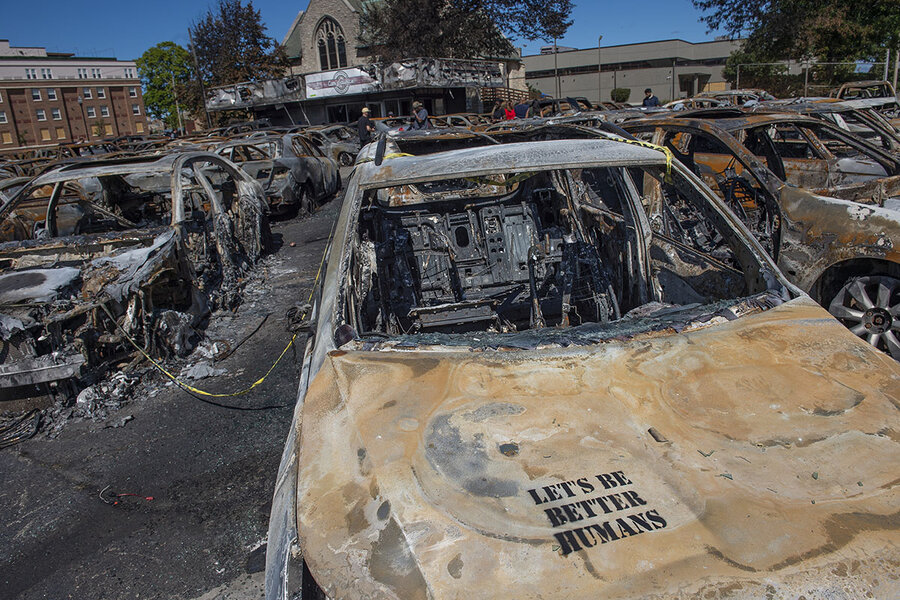
Critics fault police and National Guard troops for failing to arrest Mr. Rittenhouse, whom they passed with his hands raised after the shooting. The teenager, whose Facebook posts supported Blue Lives Matter and who said in a video early Tuesday night that he had come to protect businesses and help administer first aid to those who needed it, had been charged with speeding and driving without a valid license the previous week. He turned himself in the morning following the fatal shooting after spending the night at home. The State of Wisconsin has charged him with five felonies, including first-degree intentional homicide.
On Saturday, hundreds of protesters marched down a main boulevard to Civic Center Park, chanting “No justice, no peace,” and carrying signs that read “We bleed the same blood,” “Guns are for Cowards,” and “Jacob Blake is a Human.” Legal observers in fluorescent vests patrolled on bikes while National Guard troops watched from behind fences near the courthouse.
Veyah Witt, a young Black woman in the crowd who was born and raised in Kenosha, says she’s not surprised by the events of the past week.
“I won’t say I’m happy that this is happening. But I am happy that people here in this town are finally seeing the things that we always see,” says Ms. Witt, a first-year college student in Milwaukee. “Until now, it’s always just been pushed under the rug.”
Jacob Blake Sr. is among the speakers who took the stage as Ms. Witt and the rest of the crowd look on. “There is one justice system for the white boy who walked down the street shooting, and there is another one for mine,” says Mr. Blake. But he adds that destruction is not the appropriate response. “Good people of this city understand. If we tear it up, we have nothing.”
A barber’s nighttime vigil
Mike Johnson, a barber in the Uptown neighborhood that saw some of the greatest devastation, says that if he hadn’t been standing guard outside his business with friends and relatives during the nights of rioting, his place would have been burned down too.

“I said, ‘Back off, these are Black-owned businesses,’ and they took off,” he recounts, admitting that he and others flashed guns at the rioters. “But yeah, they definitely tried.”
He thinks the news media is creating an overly simplistic narrative to explain the events in Kenosha. “The media is pushing it into a Black and white thing, but it’s not. It’s a right and wrong thing.”
For example, he says he’s seen reports about armed white residents protecting their neighborhoods, “but Black people do that too! There’s nothing wrong with that. They gotta do what they gotta do. They’ve got kids.”
As Mr. Johnson works on a young man’s fade with gold clippers, “Big Mike,” as he’s known, describes his hopes that Uptown will come back better.
“Most people look at it and say, ‘Oh this is destruction, this is disaster,’ but we look at it like opportunity,” he says. “We need to get together as a community and start to rebuild.”
At one of the many spontaneous mural painting sites around the city this weekend, Brenda Sorenson puts the finishing touches on a Scandinavian-inspired floral design, with handprints for flowers. She and her friend Kimberly Loepp offered to paint the boarded-up storefront of Paul Rizzo’s Scandinavian Designs furniture store, which has been here since 1974. They hope such efforts will not only help business owners like Mr. Rizzo – whom they had never met until this weekend – feel supported, but also show America a different side of Kenosha than the nighttime images that are circulating on TV.
“I want them to see the community coming together,” says Ms. Sorenson. “Hopefully people who didn’t know each other before can get to know each other. Who knows, maybe that could bring down some barriers.”
“I wish every city could be like this”
Before Jacob Blake’s name echoed across America and Kenosha was set ablaze, Pastor Kirby of Acts Church and a couple of white church leaders had set a date to relaunch together as an intentionally multiethnic church, called One Voice. It happened to fall exactly one week after Mr. Blake’s shooting, when so many in the city were feeling weighed down by pain, anger, fear, and division.
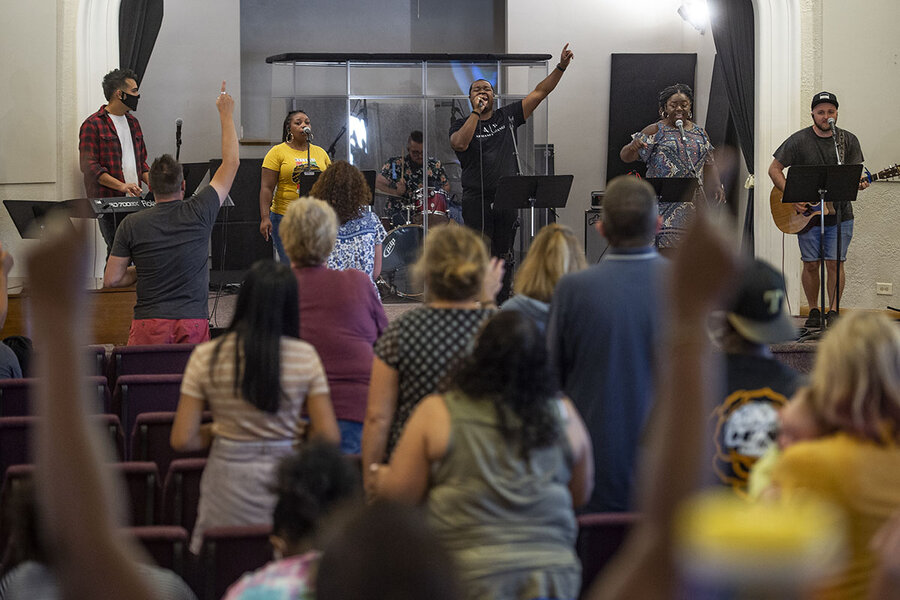
After their first service in a new building, Mr. Kirby, together with Matt Myers and David Johnson, describe this moment as an opportunity to help their city bridge those deeper divides.
“My worry is that we’re going to be so focused on rebuilding burnt buildings that we’re going to miss the divide that needs to be healed,” says Mr. Johnson, expressing appreciation for the murals around town but also emphasizing the need to make good on all those expressions of peace and love.
John Lalgee of One Church Ministries, an umbrella organization that will include the new church, suggests a divine purpose at work amid seemingly dark times, including in the coming together of more than a dozen church leaders and about 500 participants at an outdoor prayer meeting last Thursday.
“We will not be famous in the years to come for a tragic incident,” the biracial leader told worshippers at one of his congregations, Living Light Christian Church in Kenosha, on Sunday morning. “We will be famous in the years to come for the outpouring of the spirit of God and the unique coming together of the people of God.”
Already, Kenosha residents’ efforts have attracted attention and praise from outsiders. Three protesters from Baltimore, who drove virtually nonstop to Kenosha, said it was extraordinary to them how quickly the city was coming together.
“It breaks my heart for my city, because we didn’t do that,” says Rachel Gorzo, referring to the aftermath of the 2015 death of Freddie Gray in police custody. “But I’m hoping other cities can learn from Kenosha.”
“I wish every city could be like this,” agrees her boyfriend, Darnell Williams, an African American documenting the mural painting and other scenes on his cellphone.
“This positive energy – we want to bring it to Baltimore,” says Liri Fusha, their intrepid driver, who knows firsthand the impact of defunding the police and government, which she experienced in her native Albania. She hopes her adopted country won’t go down that route, but will take more seriously complaints of official corruption and misconduct.
“This country is the best country on Earth. I am so lucky to be in the U.S.,” says Ms. Fusha, who still bears the scars of being thrown down on shattered glass during the lawlessness that swept Albania in the 1990s. “But I’m hoping the U.S. is going to come together.”
Back in Uptown, leaning against his car with rap music blaring, Mr. Ross says empathy is key to addressing racial oppression in the city he loves.
“Martin Luther King marched so that I could be here talking to you right now in the street. And yeah, sure, we can drink from the same water fountain now, but there’s still this underlying stuff,” says Mr. Ross, who was born in jail to a father who had killed someone and a mother who was implicated in the crime, and who fell into bad ways himself until his own son’s death caused him to change course.
“I was raised up around oppression,” says Mr. Ross. “But I go to church. You can’t deal with violence with violence. That’s what you call a war. Ain’t nobody going to win.”

Perception Gaps
Punishment or rehabilitation? Why America locks people up. (audio)
What is the goal of incarceration? This episode of our podcast “Perception Gaps: Locked Up” looks at where human dignity fits into the debate about balancing punishment and rehabilitation.

Polls from the past few years have found that a majority of Americans – as much as 85% – say the focus of prison should be rehabilitation. But data also shows that there are still a lot of people who support punitive responses to crime. How can we reconcile these two, often competing, objectives? Is it possible to do both at the same time?
In this episode, our reporters explore the different purposes of incarceration, where the system succeeds and fails, and the gap between what we say we want prison to do and what it actually does. - Samantha Laine Perfas, Jessica Mendoza, and Henry Gass
Note: This is Episode 5 of Season 2. To listen to the other episodes and sign up for the newsletter, please visit the “Perception Gaps: Locked Up” main page.
This audio story was designed to be heard. We strongly encourage you to experience it with your ears, but we understand that is not an option for everybody. For those who are unable to listen, we have provided a transcript of the story here.
The Purpose of Prison

The Explainer
Mediterranean face-off: Greece, Turkey at ‘the abyss’
Greece and Turkey are NATO allies, but their warships are challenging each other in the Mediterranean. Turkey’s growing attitude of “hypernationalism” is making it bolder.

- Quick Read
- Deep Read ( 4 Min. )
-
By Nick Squires Correspondent
Not for the first time, fellow NATO members Turkey and Greece are at each other’s throats. But this time the flare-up between the historic rivals is especially dangerous and unpredictable, observers warn, as the neighbors’ warships patrol disputed Mediterranean waters thought to be rich in oil and gas.
Turkey, led by authoritarian President Recep Tayyip Erdoğan, appears eager to press its long-standing objections to the way maritime borders were drawn 100 years ago, in the wake of the Ottoman Empire’s collapse.
Turkish forces have recently intervened successfully in Syria and Libya, giving Mr. Erdoğan the self-confidence to pursue a highly nationalistic foreign policy. European governments have little influence over him, now that Turkey’s long-standing hopes of joining the European Union seem to have hit a brick wall.
Neither Greece nor Turkey wants to fight a war. But their warships are sailing at threateningly close quarters.
“In all likelihood there will not be a deliberate military confrontation,” says Ian Lesser at the German Marshall Fund of the United States. “Policymakers are all aware of the risks. But ... the risk of something going wrong is there.”
Mediterranean face-off: Greece, Turkey at ‘the abyss’
Tensions in the eastern Mediterranean are at their highest level in decades after Turkey sent a survey vessel, escorted by warships, to prospect for oil and gas in waters claimed by Greece.
Athens sent its own warships in, and Ankara has responded by staging live-fire gunnery exercises in the area this week.
Why are Greece and Turkey at odds?
Since the discovery of hydrocarbon deposits beneath the seabed a few years ago, both countries have claimed the right to exploit the resources. But geography complicates the dispute.
Turkey has the longest coastline in the Mediterranean and argues that it should enjoy commensurate rights to any gas and oil that is discovered. But Greece owns a scattering of islands that lie just a few miles off the Turkish coast, so Athens claims that its continental shelf extends into Turkey’s coastal waters.
The picture has been further complicated by a deal Turkey made last year with Libya to carve out a large part of the Mediterranean as their self-proclaimed joint area of interest. Greece reciprocated in early August by concluding a rival accord with Egypt.
Turkey feels hemmed in and contained by maritime demarcations that were drawn up nearly a century ago, after the First World War and the collapse of the Ottoman Empire.
“Turkey wants to demonstrate to Greece that Turkey will never accept the imposition of what it sees as an unfair partition of the eastern Mediterranean,” says Sinan Ülgen, chairman of Edam, an Istanbul-based think tank. “There is broad consensus over this within Turkey.”
Turkey’s authoritarian president, Recep Tayyip Erdoğan, is sounding a belligerent note, accusing the Greeks of acting like “pirates.”
“Turkey will take what is its right in the Mediterranean, in the Aegean, and in the Black Sea,” he said in a speech last week.
“If anyone wants to stand before us and face the consequences, they are welcome to,” he added. “If not, stay out of our way, and we will continue with our work.”

Why is the situation different from previous crises?
Simply put, because Turkey feels less constrained and is acting more self-confidently.
Greece and Turkey, who are NATO allies, nearly went to war in 1996 in a dispute over uninhabited Aegean islets. Since then they have lived in uneasy détente.
The new flare-up is particularly dangerous and unpredictable because Turkey is bolder now, observers warn. Ankara “has used its military with some success in Libya and Syria,” points out Ian Lesser, executive director of the German Marshall Fund of the United States, a think tank. “Its capacity to project power is greater than it was in the past … and Turkey is much more assertive and much more conscious of its maritime interests.”
Secondly, under President Erdoğan, Turkey is pursuing a highly nationalistic agenda, recalling the Ottoman era.
“Turkey is meddling in Libya, Syria, Iraq and the Aegean – all areas that used to belong to the Ottoman Empire,” says Angelos Chryssogelos, an expert on the eastern Mediterranean at London Metropolitan University.
At the same time, Ankara’s relationship with the West, is “almost at breaking point,” Dr. Lesser points out. “There’s a complete breakdown of trust between Turkey and European capitals. It’s become harder and harder to engage Turkey,” he says. And with Turkey’s long-mooted accession to the European Union seemingly at a dead end, the West has less leverage over Ankara than it did in previous crises.
How likely is war to break out?
Germany’s foreign minister, who is trying to intercede in the dispute, warned last week that the two countries are staring into “the abyss.”
“The situation is very risky,” said Heiko Maas. “Whoever moves closer and closer to the abyss can at some point fall down. Any spark, however small, could lead to a disaster.”
Complicating the conflict further is the number of countries involved. “It is quite different from the past, when you had just Greece and Turkey involved and the Americans trying to calm things down,” says Dr. Chryssogelos.
France and the United Arab Emirates have sent aircraft and warships to back up Greece, while Cyprus, Israel, and Egypt also have a stake in prospecting for hydrocarbons in the eastern Mediterranean.
The more warships and fighter planes there are jostling for space in the region, the greater potential there is for an accident that could lead to war, though most observers agree that neither side wants to fight.
“For Turkey, the idea is not to go to war but to place ships and planes in areas so as to stake a claim … to open up the agenda as much as possible,” says Dr. Chryssogelos.
“Erdoğan does not want war, but he is prepared to use military persuasion to back his political posture,” suggests Mr. Ülgen. “There is an environment of hypernationalism.”
“In all likelihood there will not be a deliberate military confrontation,” predicts Dr. Lesser. “Policymakers are all aware of the risks. But with more military exercises and more forces in the region, the risk of something going wrong is there.”

A Canadian First Nation reclaims the telling of its own story
How do you make headway against centuries of misunderstanding and prejudice? In Canada, one First Nations group is trying to reclaim its voice through children’s publishing.
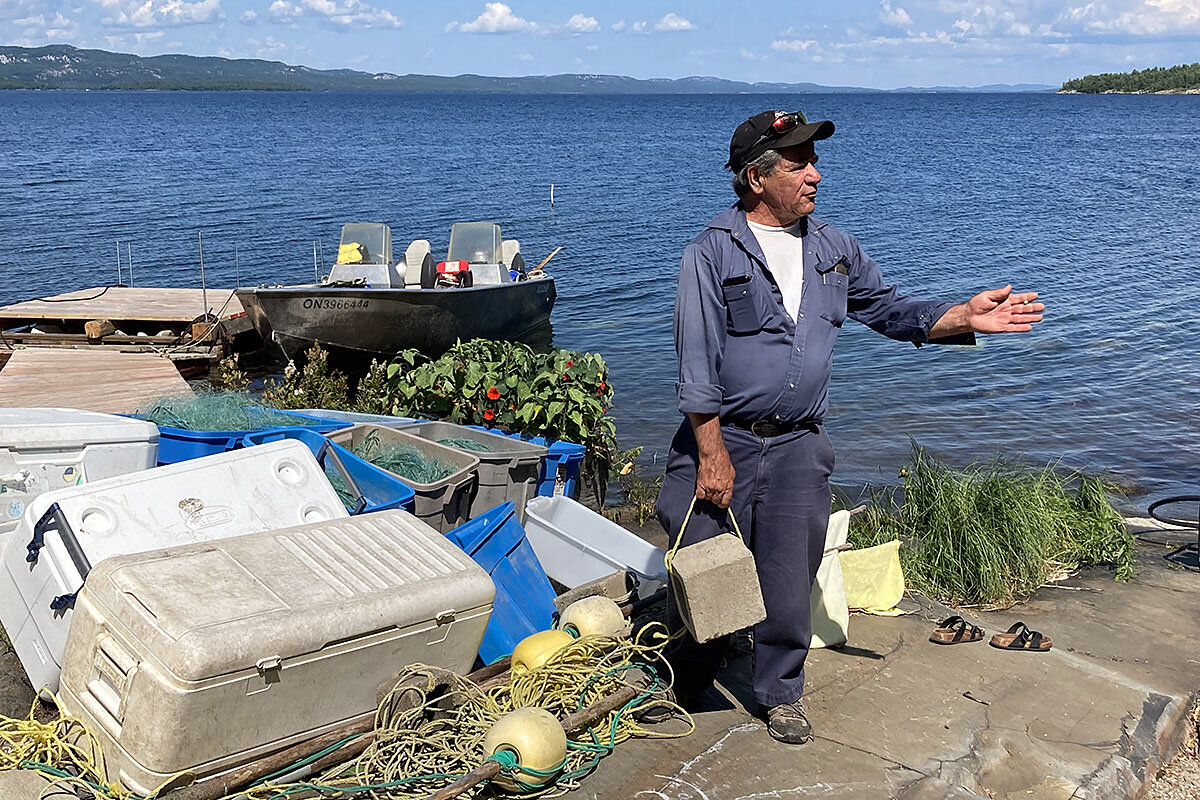
- Quick Read
- Deep Read ( 4 Min. )
On a sunny August afternoon, Dave Corbiere sets out from the dock at the Aundeck Omni Kaning First Nation in Manitoulin Island, Ontario, to catch whitefish and pickerel in Lake Huron as his forebears have done for generations.
But one could experience his life as a fisherman by flipping through his children’s book, “Whispers on the Water,” or reading about him in the pages of a magazine called Canoe Kids. It’s part of a mission to inform people who aren’t exposed to Indigenous culture beyond media portrayals, by Indigenous people themselves.
“We were very frustrated by the lack of authentic material to point teachers and parents to about Indigenous cultures and about the issues facing Indigenous people in Canada today,” says Kelly Brownbill, senior editor and cultural advisor to both the magazine and book publishing efforts.
“We want parents to be able to read a story at night that isn’t a Hollywood version of my culture. … Ninety percent of the world’s problems are caused by ignorance. But a really cool thing about ignorance is that it’s 100% curable if people will just take the time and energy.”
A Canadian First Nation reclaims the telling of its own story
Dave Corbiere powers his fishing boat to the rocks on the shore of a small island in the North Channel of Lake Huron. It’s upon this foundation that he lays a fish below an eagle’s nest, perched tenuously in the branches of a white pine, before he sets out. It’s an offering of thanks to the bird of prey that is considered sacred by the Ojibwe people – for keeping him safe on the lake and for leading a life worthy of example.
Then he assesses the water temperatures and currents in search of schools of whitefish and pickerel. He and his granddaughter Gabriella set out their nets in the evenings and hoist up the catch by hand the following morning – never taking more fish than they will use. They spend the early part of the day cleaning and packing it for sale. What they don’t sell they will share with elders in their community.
On a sunny August afternoon, my family joins Mr. Corbiere’s trip from the dock at the Aundeck Omni Kaning First Nation on Manitoulin Island, the largest freshwater island in the world.
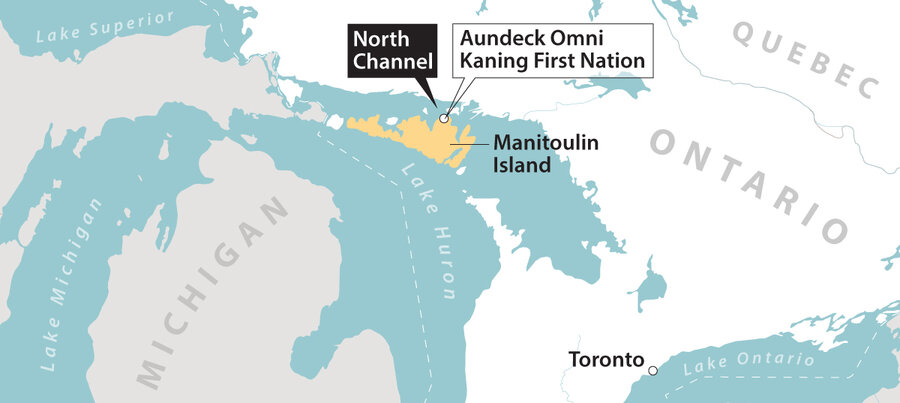
But one could experience his life as a fisherman by flipping through his children’s book, “Whispers on the Water,” or reading about him in the pages of a magazine called Canoe Kids. It’s part of a mission to inform people like myself, who aren’t exposed to Indigenous culture beyond media portrayals, by Indigenous people themselves.
“The rest of Canada doesn’t understand our culture. A lot of people think we are living in teepees,” says Mr. Corbiere. “This helps them understand us better, and understand the prejudice that is there. If kids get an education young enough, they’ll get beyond the prejudice.”
I hesitate at first but then confide that, as I told my elementary-school daughter we were entering a reserve, she used the exact wording he cited: “Oh cool, are there going to be teepees?” This despite the fact that she goes to public school in Canada, where the day begins with an acknowledgement of the traditional lands upon which each school sits – an indication of the place Indigenous culture and history are meant to hold in Canadian education. He nods at her kindly.
“Ignorance is 100% curable”
The first edition of Canoe Kids came out in 2016, before being renamed to 4Canoes in 2019. The publication was a direct response to the Calls to Action put out in 2015 by Canada’s Truth and Reconciliation Commission, established to face the atrocities endured by Indigenous children in residential schools over decades. And with debates over who has the right to tell whose story intensifying, the publishing group, which is almost entirely Indigenous, felt it was paramount that the voices featured on the pages came from Indigenous people.
“We were very frustrated by the lack of authentic material to point teachers and parents to about Indigenous cultures and about the issues facing Indigenous people in Canada today,” says Kelly Brownbill, senior editor and cultural advisor to both the magazine and book publishing efforts. “We want parents to be able to read a story at night that isn’t a Hollywood version of my culture. … Ninety percent of the world’s problems are caused by ignorance. But a really cool thing about ignorance is that it’s 100% curable if people will just take the time and energy.”
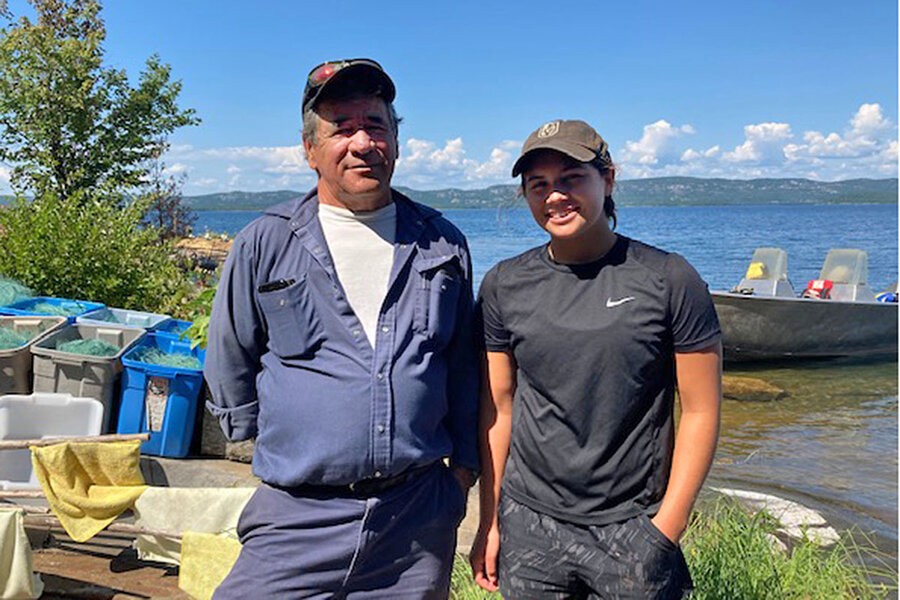
Their first edition focused on Manitoulin Island, which means “spirit island” in Anishinaabemowin, the Ojibwe language, and has long been a center of Indigenous culture – and tourism, pre-pandemic, in Canada. It introduces readers to ancient stories, to the importance of birch-bark canoes, and pau waus (powwows). It includes glossy photos and a glossary of key words in Anishinaabemowin.
Kevin Milne, a photojournalist and driver of the project, says part of the idea was to start at Canada’s center, then radiate to Indigenous cultures west and east, then south to the U.S. and throughout Latin America and beyond. The magazine and books have reached over 1 million viewers and today sit in libraries and schools across Canada.
One of the project’s four pillars is environmental rights (along with human rights, cultural rights, and equity), and that ethos is reflected in stories about the way women and men like Mr. Corbiere live a life of conservation, without necessarily even using the word, says Mr. Milne.
“Those stories are very important, they allow people who have never met an Indigenous person to connect in a way they might not be able to,” he says. “It’s a way to draw those people in, and to have a different consideration of a land-based culture.”
Another view of the world
In his book, Mr. Corbiere writes of the teachings of “the whispers of the water,” traditions passed down from his ancestors and that he is now passing down to his granddaughter. Next to illustrated photos of the pristine waters and land of Manitoulin Island, the text reads: “He teaches her where the shoals and reefs are, and where the edges drop off to great depths.”
On this afternoon, he drives us to the camp where that granddaughter, Gabriella, lives in the summer, next to her grandparents, on a rocky outcrop called the Five Islands. As we chat, a butterfly flits around their screened porch.
“It’s important to give people another world view, that there are different ways of living,” says Ms. Corbiere, who is 19. Plus, she admits it’s pretty cool to see the pictures she lives everyday as an illustrated book.
Someone else thinks it’s pretty cool too, as my daughter and I flip through the pages after we get back to our hotel for the day – and this time because she’s had a real experience, not a Hollywood interpretation.


Books
Before Serena Williams and Megan Rapinoe: Early female athletes paved way
Two new books look at a pair of women who are largely forgotten today, but were pioneers in changing the way society saw female athletes.

-
By Olive Fellows Correspondent
Before Serena Williams and Megan Rapinoe: Early female athletes paved way

Before Serena Williams and Megan Rapinoe, there was Lottie Dod and Alice Marble. The latter were well known in the late 19th and early 20th century, and as media sensations they paved the way for female sports superstars today.
Dod (1871-1960) was a British tennis prodigy, golf champion, and all-around athlete. At the tender age of 11, she began challenging adults and “leaving their tennis in tatters.” By age 21, she had racked up five Wimbledon wins; her first win at age 15 earned her the still-unbroken record for youngest ladies’ singles champion. Her story is chronicled in “Little Wonder: The Fabulous Story of Lottie Dod, the World’s First Female Sports Superstar” by Sasha Abramsky.
Yet, at the peak of her power, Dod left tennis. She craved a new challenge. Throughout her 20s and 30s, she bounced from sport to sport, achieving a string of successes not just in tennis and golf, but also in hockey, ice skating, tobogganing, and mountain climbing. She closed out her impressive career by winning a silver medal in archery at the 1908 Olympics.
Dod challenged the prevailing image of the “delicate” female athlete, who was considered inferior to her male counterparts. She was vocal in her belief that women could be just as successful in sports as men. After her death, The Guardian called Dod “one of the most remarkable sportswomen of the 19th century.”
Abramsky presents a well-researched account of a woman whose rare losses were almost more newsworthy than her consistent victories.
The tennis world’s comeback kid
American tennis player Alice Marble (1913-1990) captured the world’s attention and multiple titles beginning in the mid-1930s. As detailed in Robert Weintraub’s “The Divine Miss Marble: A Life of Tennis, Fame, and Mystery,” Marble possessed a great deal of innate talent, but it wasn’t until coach Eleanor “Teach” Tennant agreed to instruct her that she morphed into a champion.
The road to the top wasn’t easy. Several health crises threatened to end her career, and she left the circuit for two years to recover. She made a triumphant return in 1936, when she won the U.S. National Championships (now known as the U.S. Open).
Her comeback story along with her televised matches made the public fall in love with Marble. Her friendships with movie stars such as Carole Lombard and Clark Gable gave her a reputation of rubbing elbows with Hollywood royalty. She became a glamorous figure in her own right and gained a platform for her other projects, including sportswear design.
Much of Marble’s life remains shrouded in mystery. Though she wrote not one but two memoirs, questions persist. Was she married to an officer who died in World War II? Did she serve as a spy? Weintraub uses Marble’s memoirs as the foundation of his research, and his discoveries turn this sports biography into a page-turning thriller.
These two biographies serve not only as opportunities to marvel at the accomplishments of these women, but also as reminders that some things haven’t changed. For example, Dod and Marble were criticized for how they dressed, accused of playing like men, and berated for their progressive political views. These books are celebrations of women’s progress, but they also show how much work is left to be done.
Other headline stories we’re watching
(Get live updates throughout the day.)The Monitor's View
A peace deal to piece Sudan together
- Quick Read
- Deep Read ( 2 Min. )
-
By the Monitor's Editorial Board
The world took note last year when youthful protesters in Sudan forced the ouster of a longtime dictator, Omar al-Bashir. Yet just as noteworthy was their use of nonviolence and democratic unity – a direct rebuke of Mr. Bashir’s divide-and-rule tactics in an African nation splintered by ethnicity, religion, and regionalism. Now that approach is paying off. On Monday, most of the rebel groups that fought the Bashir regime inked an agreement that would give them a large slice of power in their regions and in the capital, Khartoum. The spirit of the protests – building national identity around a culture of peace and inclusion – was baked into the pact.
The pro-democracy protests that began in December 2018 put Sudan on a path toward creating an identity built on equal citizenship and shared ideals. The atrocities of the past still need to be addressed. Rebel groups must be integrated with a reformed military. Yet young Sudanese now know they no longer must accept rulers who stay in power by trying to convince them they have enemies. Power in Sudan has shifted to those who embrace the basic dignity of their fellow citizens.
A peace deal to piece Sudan together
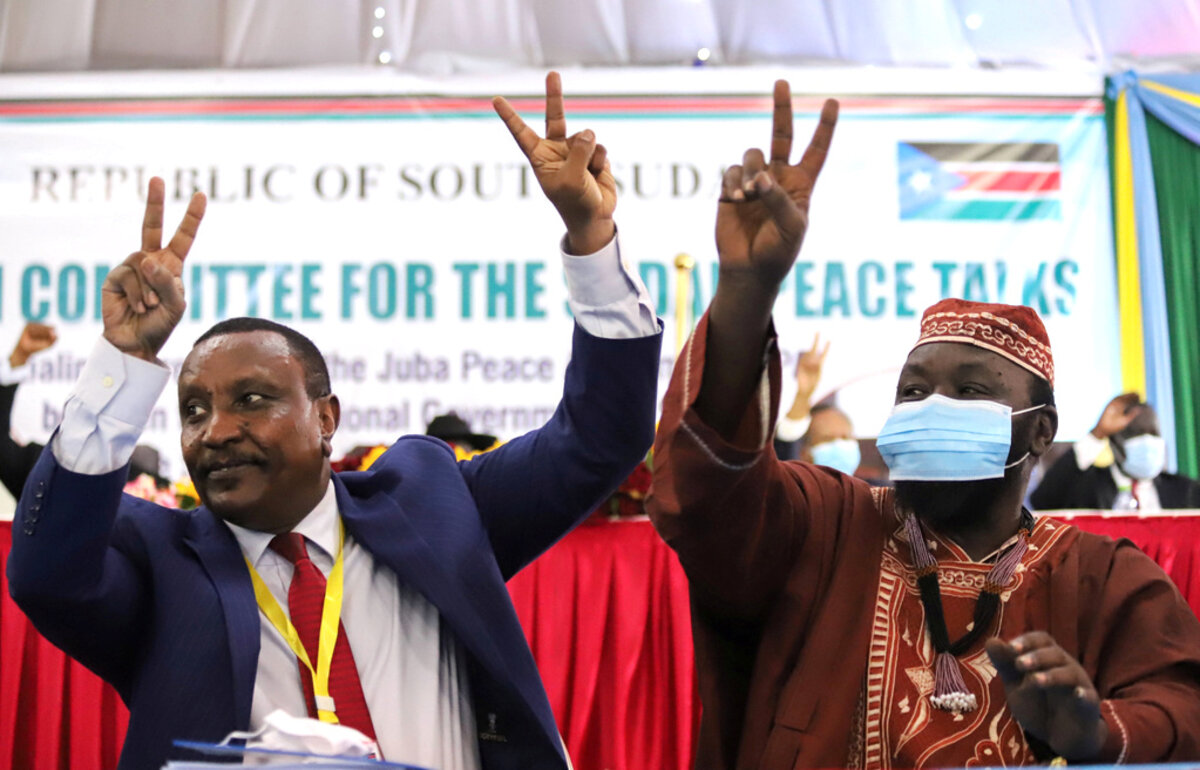
The world took note last year when youthful protesters in Sudan forced the ouster of a longtime dictator, Omar al-Bashir. Yet just as noteworthy was their use of nonviolence and democratic unity – a direct rebuke of Mr. Bashir’s divide-and-rule tactics in an African nation splintered by ethnicity, religion, and regionalism. Now that approach is paying off in Sudan’s slow transition to democracy and a possible election in 2022.
On Monday, most of the rebel groups that fought the Bashir regime inked an agreement that would give them a large slice of power in their regions and in the capital, Khartoum. Resource wealth would be more evenly distributed. The spirit of the protests – building national identity around a culture of peace and inclusion – was baked into the pact.
The peace talks took longer than expected in part because Africa’s third-largest country has been in civil conflict for most of the 70 years since independence, leaving millions killed or displaced. Two rebel groups in fact did not sign the agreement out of demands for even more change, such as ensuring secular government in a country that is largely Islamic. Sudan, a nation of 40 million, is where the Arab world meets sub-Saharan Africa.
The negotiations also needed to be nudged along by foreign powers. “This is the time for all Sudanese stakeholders to set aside their differences and to look for the greater good of the country and of all Sudanese,” commented Josep Borrell, the European Union’s envoy for foreign affairs, after the pact was finished.
The pro-democracy protests that began in December 2018 put Sudan on a path toward creating an identity built on equal citizenship and shared ideals. The atrocities of the past still need to be addressed. Rebel groups must be integrated with a reformed military. And Sudan’s entrenched patronage networks must be dismantled. Much of the nation’s wealth, for example, is centered around Khartoum, making the regions highly dependent on the capital’s elite.
Yet young Sudanese now know they no longer must accept rulers who stay in power by trying to convince them they have enemies. Power in Sudan has shifted to those who embrace the basic dignity of their fellow citizens.

A Christian Science Perspective
Each weekday, the Monitor includes one clearly labeled religious article offering spiritual insight on contemporary issues, including the news. The publication – in its various forms – is produced for anyone who cares about the progress of the human endeavor around the world and seeks news reported with compassion, intelligence, and an essentially constructive lens. For many, that caring has religious roots. For many, it does not. The Monitor has always embraced both audiences. The Monitor is owned by a church – The First Church of Christ, Scientist, in Boston – whose founder was concerned with both the state of the world and the quality of available news.
Inherently clean
- Quick Read
- Read or Listen ( 3 Min. )
-
By Mark Swinney
These days we’ve all been charged with being especially mindful of cleanliness. We can apply this not just to our hands and surfaces around us, but to our thoughts, too – letting God’s purity wash us clean of fear and illness.
Inherently clean
These days people are being asked to give particular care to cleanliness. I like to think of this as relevant not just to sanitizing ourselves and our environment, but also to addressing “contamination” of a mental nature, such as entertaining fear.
Fear is not the path to progress and healing. “Keep in mind,” writes Dr. Lissa Rankin on her website, “that the news media’s job is to keep you informed about global events, but it’s also their job to get your attention and sell ad space. Panic sells.”
Panic may sell, but that doesn’t mean we need to buy it. Christian Science reveals how truly overcoming fear comes not from being personally brave, but from understanding the nature of God, whom the Bible calls Spirit and Love. As we learn more about our tender relation to this all-good and all-loving God, we become more settled, mentally washed clean of fear.
God sees us all in only one way: as His flawless, pure, spiritual creation. The Bible says of God, “You are of purer eyes than to behold evil, and cannot look on wickedness” (Habakkuk 1:13, New King James Version). Things like anger, resentment, fear, and self-will don’t make us feel all that pure, but those things are not part of God, good, or God’s creation – so they are never an inherent part of us. As we realize that these mental states are not part of our God-created identity, our thought is increasingly purified of them.
The spiritual identity God has given us is more than just a philosophical concept. It is actually tangible and knowable. Jesus once encountered a man with a contagious skin disease who told him, “If thou wilt, thou canst make me clean.” With confidence in the fact that, contrary to appearances, this man was the pure offspring of God, divine Spirit, Jesus clearly wasn’t afraid. In fact, he responded, “I will: be thou clean.” In that instant, the man was healed (see Luke 5:12-15).
Through prayer, can’t we also expect to be made clean of fear or illness? Yes. It happens as we turn to our divine Shepherd, divine Love, and learn something more of God’s infinite goodness and care for us. God is here, not sporadically, but eternally.
This was made clear to me when I inadvertently swallowed a harsh chemical agent. Quickly, my throat swelled, but just as quickly, I turned to God in prayer. It was tempting, and scary, to believe that I had been contaminated by this accident.
Instead, I began considering the purity of God. I acknowledged then and there how much I love that we are, in fact, the very expression of God’s nature.
Prayerful thought made clean by God is a perfect defense. As I embraced the simple yet deep, inspired fact of my spiritual purity, it healed me in a few moments. Not only did the discomfort and swelling completely vanish, I felt happily clean of fear and very much renewed.
We become most unafraid not by telling ourselves to be fearless, but by letting the spiritual idea of divine Truth, or Christ, purify our thoughts, washing them of the notion that Spirit or Spirit’s immortal offspring can be threatened. To the extent that this occurs, we show forth the truth of God’s nature. “In proportion to his purity is man perfect; and perfection is the order of celestial being which demonstrates Life in Christ, Life’s spiritual ideal,” states “Science and Health with Key to the Scriptures” by Mary Baker Eddy, the discoverer of Christian Science (p. 337).
What an encouraging statement to realize that our purity corresponds to the nature of divine Life, God. God is 100% pure and perfect, so as God’s expressions we are 100% spiritual and utterly pure. Moment by moment, thought by thought, we can open our hearts to this truth of our nature. We can maintain spiritual freshness by letting God’s spiritual goodness and purity shine through. This is a clean state of thought that has the power, not just of human thinking, but of God, divine Truth, behind it.
And this is the call for today. Through heartfelt prayer, with God’s loving help, we can confront and overcome impurities in our thoughts and lives. With these words from the Bible, we can joyfully pray: “Create in me a clean heart, O God; and renew a right spirit within me” (Psalms 51:10).

A message of love
Back to basics
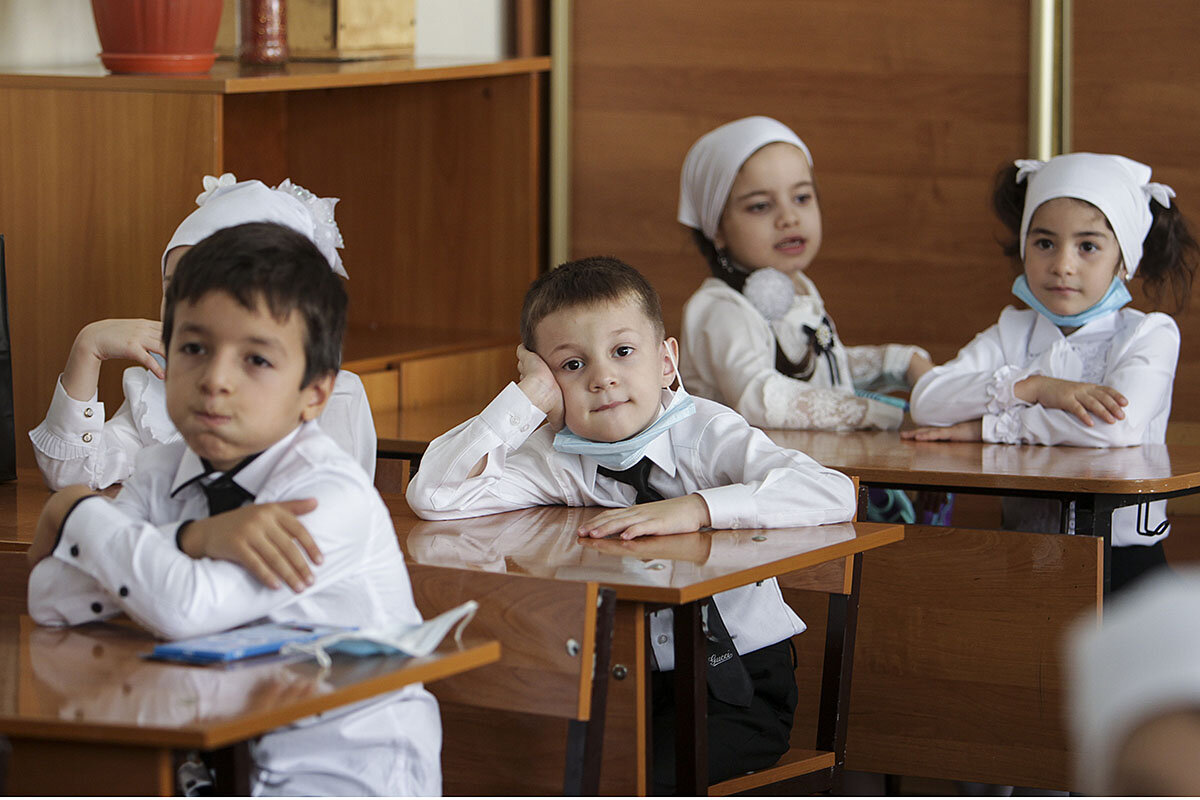
A look ahead
Thank you for joining us today. Tomorrow, we have a story about the karate grannies of Kenya because, well, they’re totally awesome.



